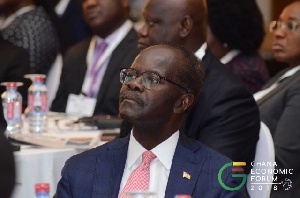 Dr. Owusu Afriyie Akoto, Minister of Agriculture
Dr. Owusu Afriyie Akoto, Minister of Agriculture
For two years running the country’s agriculture sector has experienced declines in growth, despite an impressive performance in 2017 after the government introduced the Planting for Food and Jobs (PFJ) programme.
Annual GDP figures released by the Ghana Statistical Service show that the country’s largest employer – the agriculture sector – grew by 4.6 percent in 2019, a 0.2 percentage point decline from that of 2018, making it the slowest growth since growth jumped to 6.1 percent in 2017 from the 2.9 percent it recorded the previous year.
That is not all: the 2019 growth of 4.6 percent was also the least recorded in all three sectors of the economy, as industry and services grew at 6.4 percent and 7.6 percent respectively. Looking at the data from when rebasing of the economy took effect (2014), the Agriculture sector has constantly trailed the other two sectors in growth – with the exception of 2015 when it surpassed industry by 1.2 percentage points.
This clearly shows that the sector, which is considered the spine of the economy, is in perpetual distress; and as such, deliberate measures must be implemented to bring back its glory of being the largest contributor to GDP. Currently, the sector contributes the smallest to the economy at a paltry 18.5 percent, compared to Industry’s contribution of 34.2 percent and Services’ – the new master of the economy – 47.2 percent contribution.
This trend is worrying, especially at a time government seems to be making some investments in the agriculture sector through the PFJ programme.
To Professor Emmanuel Bobobee, an agriculture engineer and an associate professor at the Kwame Nkrumah University of Science and Technology (KNUST), until big investors come and inject huge capital and take agriculture as a business, nothing much can be gained from the sector irrespective of whatever intervention is made by the government.
“They say the private sector is the engine of growth, and in agriculture, all the farmers are from the private sector; but they are smallholder farmers. We are talking about big capital entrepreneurs coming to invest in the sector. For example, when you look at South Africa some smallholder farmers there have farms the size of about 500 hectares. They have taken agriculture as a business and we have taken it as a way of life, so we approach it differently.
“The banks are not supporting the sector so there is no credit facility to expand. But we can’t blame the banks that much, because they cannot finance smallholder farmers who rely on hoes and cutlasses to farm. And because most farms are of small nature, all the research that we are doing in the area of high-yielding varieties is not translating into massive results because these smallholders do not have the motivation to expand,” he said in an interview with the B&FT.
Again, the professor said the aging farmer population is also a matter for serious concern, as it is drawing the sector back since there is no fresh energy and enthusiasm to drive agriculture. This observation is true, as most of the youths are not attracted by anything to do with agriculture. The majority of the youthful population have found themselves working in the services and industrial sectors, as the sector offers more white-collar jobs to them.
The Planting for Food and Jobs programme
The Planting for Food and Jobs programme was introduced by the Akufo-Addo-led administration in 2017 when it took over the reins of government. According to the 2019 budget statement, a total of 577,000 farmers under the programme were supplied with subsidised fertilisers and seeds for the 2018 cropping season.
And in 2019, the budget states, 81 percent of the targetted 19,533mt of seeds and 86 percent of the targetted 342,200mt of fertilisers were distributed to 92 percent of the targetted one million farmer-beneficiaries as at September 2019.
Again, the budget adds, two facilities worth US$216million became available for the import of farm machinery and equipment suitable for smallholders in 2019. The machinery and equipment for land preparation, planting, harvesting, and primary processing will be used to revive the 168 existing Agricultural Mechanisation Services Centres (AMSECs) as well as establish new ones where necessary.
If all these investments are actually made, then it would be fair to conclude that the government is really interested in the growth of the sector. However, such investments may not be rightly targetted, or something else is not working properly to make it reflect on the national level.
- 'Planting for Food and Jobs' not massive, transformative enough – Citizen Kofi
- Food is expensive despite PFJ programme – IEA
- Build more irrigation facilities - Physically-challenged farmer to Akufo-Addo
- 300 pick-ups given to extension officers – Agric Minister
- I’m a beneficiary of NPP’s Planting for Food and Jobs - Former NDC MP
- Read all related articles












